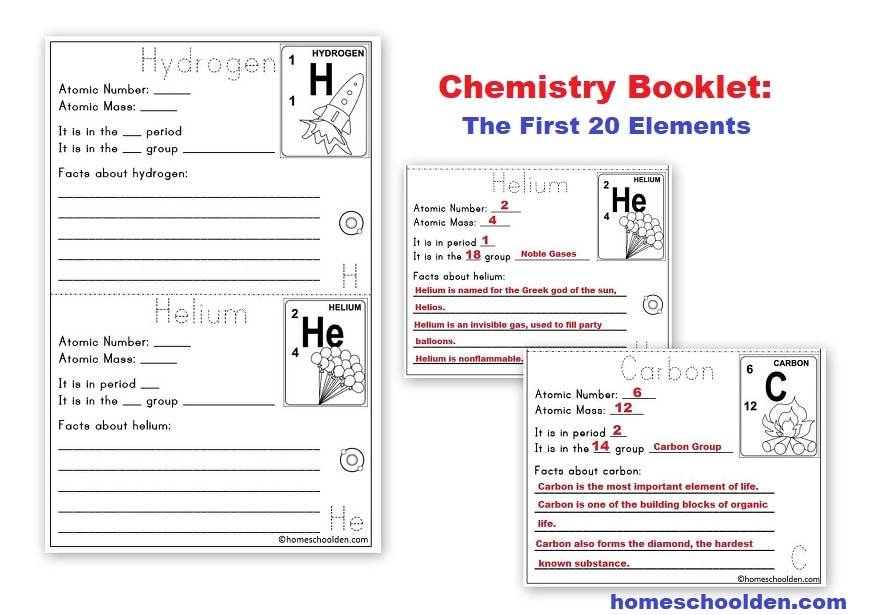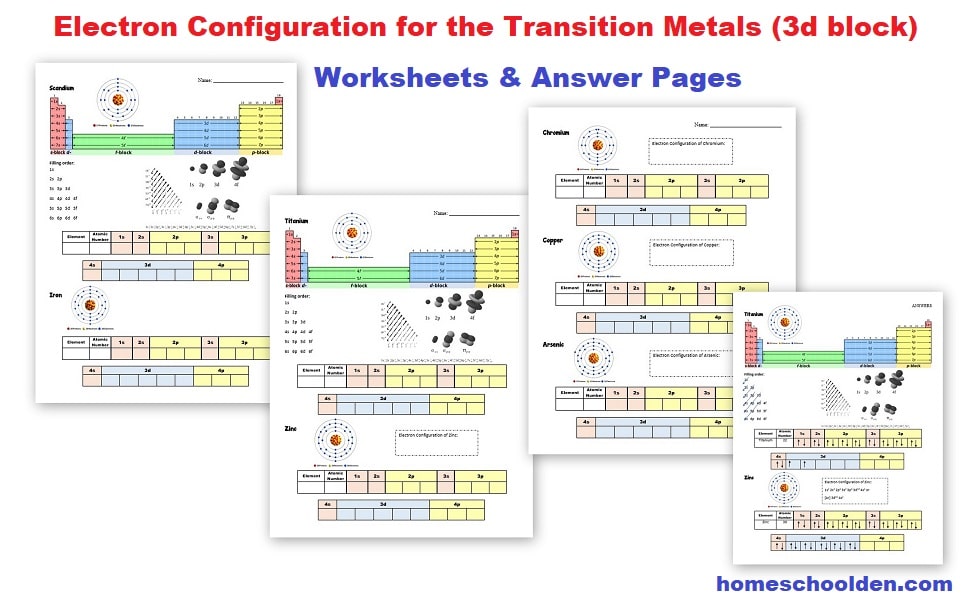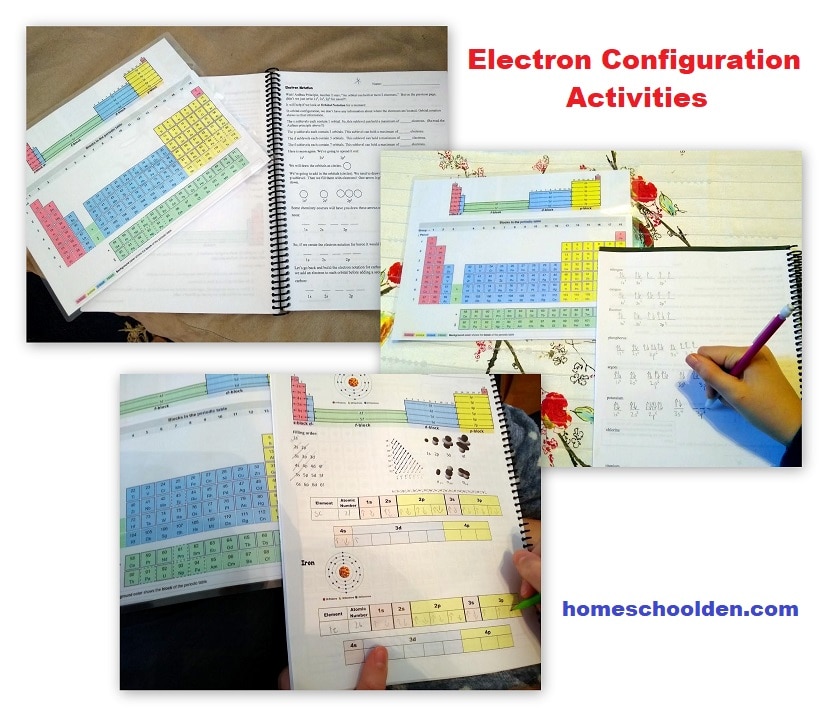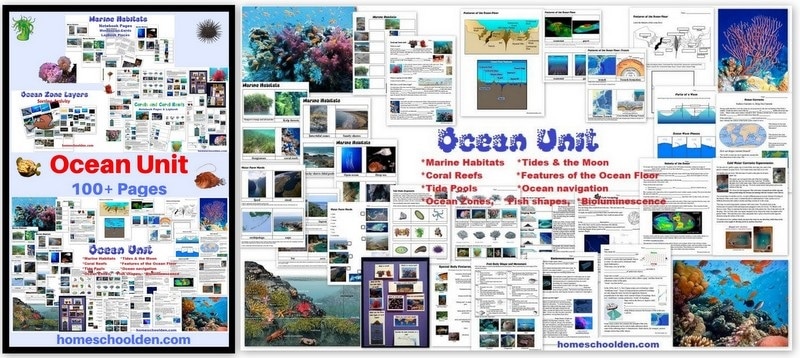Chemistry Unit – Periodic Table, Valence Electrons, Periods, Groups, Lewis Diagrams and More!
 150+ Page Chemistry Packet!
150+ Page Chemistry Packet!
I am excited to share our new chemistry unit with you! (It has been recently updated and now is around 150 pages!!) As you know, we love hands-on activities and I want to show you some of the fun ways we explored the periodic table and touched on topics like valence electrons, Bohr Diagrams, Lewis Diagrams (electron dot diagrams), ions, isotopes, and more!
Some of the topics we explored included:
- Building the Periodic Table
- Bohr Diagrams & Understanding Valence Electrons
- Periods, Groups & Families
- hydrogen & the alkali metals, alkaline Earth metals, halogens, noble gases
- Atomic Number, Atomic Mass & Chemical Symbols
- Lewis Diagrams
- Metals, Metalloids and Nonmetals
- Unusual Element Symbols
- Trends of the Periodic Table
- Electron Configuration
Click here to save this on Pinterest

Note: Chemistry for Elementary — My youngest enjoyed the unit, but some of the topics we touched on as the unit went on were a bit above her head. (She still wanted to participate but acknowledged it was challenging for her!) Be sure to this post Fun, Simple Science Experiments for Younger Kids! (Introducing Kids to Chemistry) if you have younger kids (It has a free Chemistry Experiment Packet for young learners.)
The First 20 Elements and Elements with Unusual Symbols:
Update: There are two new chemistry booklets on the first 20 elements and on elements with unusual symbols in this packet. My youngest was in 5th grade she worked on these pages. 🙂
She used a beautiful book about the elements by Theodore Gray Elements: A Visual Exploration of Every Known Atom in the Universe (affiliate link) as a reference. It has huge pictures of the elements as well as pictures of items that use this element.
This booklet had her find out: the atomic number, atomic weight, period and group numbers. Plus, there was some space for her to write some basic facts about each element.
My 5th grader also spent some time building molecules.
- We have the Molecular Model Kit (affiliate link) for building molecules.
Period Table Hands-On Activities
This was the first activity we did as we started looking closely at the Periodic Table:

Note: There are cards for the elements 1 (hydrogen) through 36 (krypton) included in the Chemistry Packet.


- each row/period added on “shell” (or ring) around the nucleus
- each column/group had the same number of electrons in the outer ring (except for helium)
Note: There are Bohr Diagram cards for elements 1 (hydrogen) through 20 (calcium) included in the Chemistry Packet.

They also did the worksheet I made for them which has them look at the number of shells and number of valence electrons various elements have.


We went on to talk about Lewis Diagrams. These are similar to Bohr Diagrams, but only provide information about the valence electrons (the outer electrons of an element). By this time, the kids were able to whip through this worksheet (using the Bohr Diagram cut-and-paste activity above):

Our next topic was about metals, nonmetals and metalloids and how this information can help us understand different types of bonds that are formed. We talked (briefly) about covalent and ionic bonds. We talked about that in covalent bonds electrons are shared, which in ionic bonds atoms give their atoms away. It was beyond the scope of this unit to go into much more detail than this, though I did touch on electronegativity charts. We looked at the Pauling Table and talked briefly about how that chart can help scientists determine/understand the types of bonds that are formed. (There is a page about that in the chemistry packet.)


One afternoon, I brought out some ping-pong balls and cups. The kids thought that was funny and enjoyed trying to bounce the ball into the correct cup! 🙂 Below you can also see some of the chemistry review cards I made for the kids (with many of the terms they learned during this unit… from proton and neutron to halogen, covalent bond, and anion and atomic number.
You might end your chemistry unit there or you can go on to talk about electron configuration.
With my older two (and now with my youngest, age 13), we talked about electron configuration & electron notation. (For example, oxygen is 1s2, 2s2, 2p4 — does that ring a bell from you high school chemistry days?!)
My kids thought it was tricky at first, but then quickly got the hang of it.
I have just updated this section to add in a number of colorful sheets (that go along with the s-block, p-block, d-block and f-block colors on the reference pages):

Here are a few close-ups of this material:

Do I need any specific books with this unit?
No, our notebook pages and worksheets include answer pages and teacher notes. There are several chemistry resources I’m glad I had on hand, though. These are affiliate links:

Chemistry Homework Helpers by Greg Curran – This is fairly advanced (and I didn’t use it with the kids), but was really useful for me as the instructor.
Glencoe Chemistry Matter and Change – I purchased quite a number of used high school chemistry textbooks (8!! Crazy right?!!) and after going through these, the one textbook we wound up using a lot (for my high schoolers) was this textbook. It has all the answers to the practice problems in the back (not just the odd answers!). We used this A LOT when my kids covered high school chemistry, but I was glad I purchased it when my kids were in middle school so I could use it as a reference.
One Mom asked if this packet is suitable for someone with little to no chemistry knowledge.
Here was my answer! Yes! I provided all of the answers and actually added in quite a number of teaching hints along the way. I designed the activities so that the kids discover some of the patterns of the Periodic Table themselves. (That’s why Bohr Diagrams are really useful, if a little outdated in our knowledge of atoms!)
In this packet, I have a general guide at the beginning of the packet of what we did on day 1, day 2, etc. b/c I thought some parents might want a bit more guidance. I tried to make it pretty straight-forward (so even wrote out instructions for what I said to the kids on certain days and what hints I gave to help them discover the answers/patterns for themselves.
Feel free to email me if you have any questions! ~Liesl
The Chemistry Packet is $8.99. It has been updated and is now well over 150 pages! Our units are PDF downloads. Be sure to check out the Chemistry BUNDLE option!
Chemistry Packet: $8.99
Don’t forget to check your PayPal email address for the download link.

Hope you enjoy this unit and learn as much as we did! ~Liesl
What chemistry units should I do after this one? If you have already covered the Properties of Matter with your kids, then they might be ready to do the Ions & Isotopes Unit. We did the Introduction to Organic Chemistry Unit both during high school biology and at the end of our high school chemistry class.
Find out more about the Chemistry BUNDLE Options here or scroll down below.
$27.99 Chemistry BUNDLE of 6 1) Introduction to Chemistry Activities 2) States of Matter Packet, 3) Properties of Matter Packet, 4) Electricity & Circuits Packet, 5) Chemistry Packet 6) pH Scale – Acids and Bases Worksheet Packet
$44.99 Chemistry BUNDLE of 8 The Chemistry BUNDLE includes 1 ) Introduction to Chemistry Activities 2) States of Matter Packet, 3) Properties of Matter Packet, 4) Electricity & Circuits Packet, 5) Chemistry Packet, 6) pH Scale – Acids and Bases Packet (The following two units should be done after the Chemistry Unit so that students understand the basics of the periodic table, valence electrons and how to create Bohr diagrams.) 7) Ions & Isotopes Chemistry Unit 8) Organic Chemistry Packet (high school unit which we used both in biology and chemistry)
You can also purchase these chemistry packets separately
$2.99 Introduction to Chemistry – Size of Atoms Mini-Unit
$5.99 States of Matter Packet (50+pages)
$7.99 Properties of Matter Packet (now close to 100 pages)
$6.99 Electricity & Circuits Packet (30+pages)
$8.99 Chemistry Packet – An introduction to the Periodic Table (150 pages) – Learn how the periodic table is organized and find out more about the different groups of the periodic table (Alkali metals, alkaline earth metals, halogens). Learn what valence electrons are and do some fun activities to create Lewis structures. Learn about the first twenty elements as well as elements with unusual names. Plus, learn about electron configuration and more! (We did this primarily in middle school, but did electron configuration in high school again.)
$2.99 pH Scale – Acids and Bases Worksheet Packet (25 pages) – Includes material for younger students (elementary/middle school) and older (high school) students.
$7.99 Ions and Isotopes Chemistry Unit (125 pages) This unit is an introduction to ions (which have fewer or more electrons) and isotopes (which have fewer or more isotopes). This unit should be done after students have completed the Chemistry Unit. (middle school/high school)
$9.99 Organic Chemistry Unit (100+ pages) Organic chemistry is the chemistry of carbon-containing molecules. In this unit, we study many of the organic compounds that include carbon and hydrogen (hydrocarbons), carbon-carbon molecules and more! This unit covers hydrocarbons, functional side groups and the four classes of macromolecules: carbohydrates, proteins, fats and nucleic acids. *high school level unit
—————————
You can find out more about each of these packets at the Chemistry BUNDLE page (or keep scrolling below)
Click on the link to see more details about each of these units:
Introduction to Chemistry – Size of Atoms Mini-Unit
Matter: Elements, Compounds, Mixtures; Organization of the Periodic Table; Molecular vs. Structural Formulas; Describing Matter: Physical and Chemical Properties; Density Activities – Mass÷Volume; Mixtures: Solutions, Colloids and Suspensions (suggested for grades 5-8)
pH Scale – Acids and Bases Worksheet Packet
High School Chemistry Units:
Ions and Isotopes Chemistry Unit (Click here to see the full post!)
You might also be interested in our Biology Units:
Visit this Biology Bundle Page for more details (and lots more pictures!)
$44.99 Biology BUNDLE of 6: 1) Biology Unit (Biomes, habitats, food chains/webs, feeding relationships) 2) Scientific Classification & Taxonomy Packet 3) Ocean Unit & Layers of the Ocean/Ocean Zone Activities 4) Cells Unit 5) Botany Unit 6) New! Pathogens Unit – Bacteria, Protozoa, Fungi, Parasites/worms; Viruses and Prions
These units are also sold separately.

Again, you can see the Biology BUNDLE Page for lots more pictures!
Don’t forget to check your PayPal email address for the download link from SendOwl (the delivery service I use)!
You might also want to check out our Earth Science & Physical Science Materials: Again, the units are sold separately or in various bundle options.
P.S. If you have younger kids, you might want to check out this post Fun, Simple Science Experiments for Younger Kids! (Introducing Kids to Chemistry)
It includes some free resources including a Chemistry Experiment Packet I made for ED when she was in Grade 2.
Don’t forget to check your PayPal email address for the download link. Feel free to email me if you need help! ~Liesl
See you again soon here or over at our Homeschool Den Facebook Page! Don’t forget to Subscribe to our Homeschool Den Newsletter. You might also want to check out some of our resources pages above (such as our Science, Language Arts, or History Units Resource Pages) which have links to dozens of posts. You might want to join our free Homeschool Den Chat Facebook group. Don’t forget to check out Our Store as well.

The Welcome Series includes 5 packed emails… with tips on homeschooling, keeping motivated, finding various resources and freebies tucked away on the blog and more!
Plus, you’ll be the first to hear about new packets (generally offered at a discount when they are first released), seasonal resources and more!
Disclosure: Please note that some of the post in this blog are affiliate links, and at no additional cost to you, I will earn a commission if you decide to make a purchase.





























































































